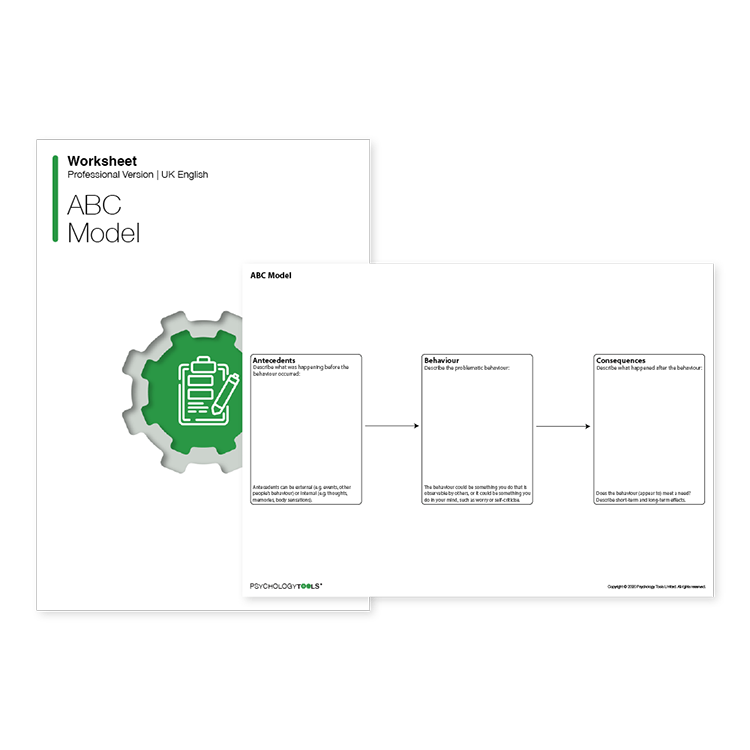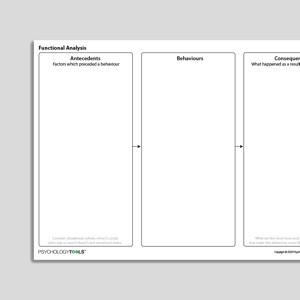ABC Model
ABC is an acronym for Antecedents, Behavior, Consequences. It is used as a tool for the assessment and formulation of problem behaviors and is useful when clinicians, clients, or carers want to understand the ‘active ingredients’ for a problem behavior. The ABC Model worksheet can be used to identify the triggers for a behavior by monitoring environmental (e.g., location, company, time of day, visual and auditory stimuli) and internal circumstances (e.g., emotions, body states, thoughts, memories) which occur before the behavior. Attention is also then drawn towards the consequences of the behavior: both short-term and long-term, intended and unintended. The ABC technique is used across a wide variety of settings. These include clinicians working with verbally capable adult clients, carers working in residential settings, parents who want to better understand their child’s behavior, and teachers trying to understand problem behavior in the classroom. When working with clients who are able to engage with talking therapies and reflect on their behavior, the ABC Model is a helpful tool for building the client’s awareness of the triggers for their behavior, and the consequences of their actions. When working more cognitively, some clinicians choose to adapt the model slightly to explore the sequence: Antecedents > Beliefs (Thoughts) > Consequences.

Related resources
Tags
Languages this resource is available in
- Albanian
- Arabic
- Bengali
- Chinese (Simplified)
- Croatian
- English (GB)
- English (US)
- Finnish
- French
- German
- Greek
- Hindi
- Hungarian
- Indonesian
- Italian
- Korean
- Latvian
- Norwegian
- Polish
- Portuguese (Brazilian)
- Portuguese (European)
- Spanish (International)
- Swedish
- Turkish
- Ukrainian
Problems this resource might be used to address
Techniques associated with this resource
Mechanisms associated with this resource
Introduction & Theoretical Background
ABC is an acronym for Antecedents, Behavior, Consequences. The ABC Model is used as a tool for the assessment and formulation of problem behaviors. It is useful when clinicians, clients, or carers want to understand the ‘active ingredients’ for a problem behavior (Yomans, 2008). The ABC model helps practitioners and clients to carefully consider what happens in the individual and the environment before a target behavior (the Antecedents) and afterwards (the Consequences): these are also known as the contingencies that shape the behavior. Once these contingencies are understood, interventions can be designed to shape or modify the target behavior.
“Individuals are typically unaware of the contingencies controlling their behaviour” (p.43, Persons)
One powerful feature of the ABC Model is that it focuses on the relationship between an observable behavior and the environment in which it occurs. This moves the focus away from an individual’s particular diagnosis or history, and towards making changes
Therapist Guidance
“When we want to know more about a particular problem, we can use a tool called the ABC model to understand more about it. First, we will think about the behavior we want to know more about, and then we will think about some specific times that it has happened.”
1. Identify the target behavior about which you want to understand more. This behavior might be something the client finds problematic or distressing. Where the client is a young child or has reduced mental capacity, it can be a behavior that is problematic for their carers, loved ones, or those around them.Identifying the target behavior is not always straightforward, and it is common for there to be multiple related problem behaviors. The behaviors targeted should be a high priority for the client rather than the symptoms defined by their diagnosis. The behavior can be effectively
References And Further Reading
- Carr, E. G. (1977). The origins of self-injurious behavior: A review of some hypotheses. Psychological Bulletin, 84, 800–816.
- Carr, J.E. & LeBlanc, L.A. (2003) Functional Analysis of Problem Behaviour, Ch. 28 in W. O’Donohue, J.E. Fisher, S.C.Hayes (Eds) Cognitive Behaviour Therapy: Applying Empirically Supported Techniques in Your Practice. John Wiley & Sons, New Jersey.
- Haynes, S.N. & Hayes O’Brien, W. (2000) Principles and Practice of Behavioural Assessment. Kluwer Academic / Plenum Publishers: Applied Clinical Psychology Series, London.
- Iwata, B. A., Pace, G. M., Dorsey, M. F., Zarcone, J. R., Vollmer, T. R., Smith, R. G., et al. (1994). The functions of self-injurious behavior: An experimental epidemiological analysis. Journal of Applied Behavior Analysis, 27, 215–240.
- Kuyken, W., Padesky, C.A., Dudley, R. (2009) Collaborative Case Conceptualization: Working Effectively with Clients in Cognitive-Behavioral Therapy. The Guildford Press, London.
- Lerman, D.





